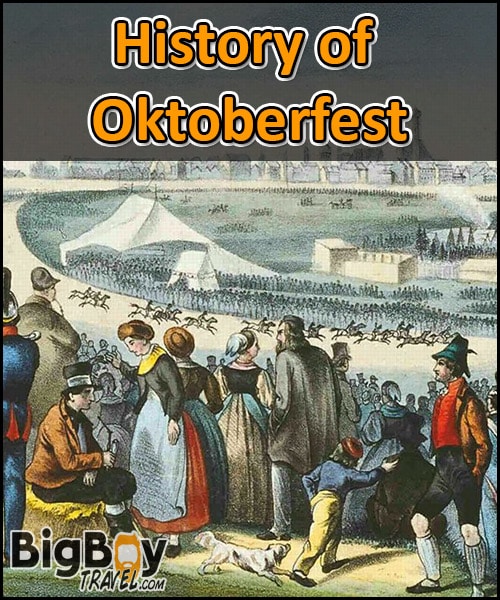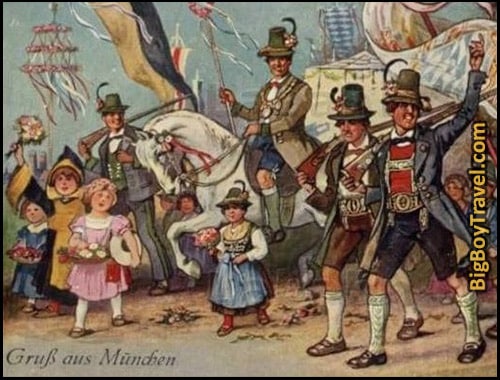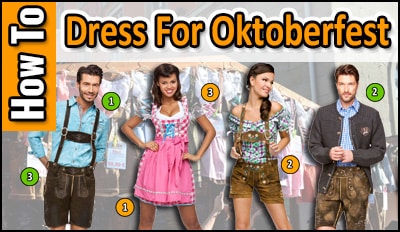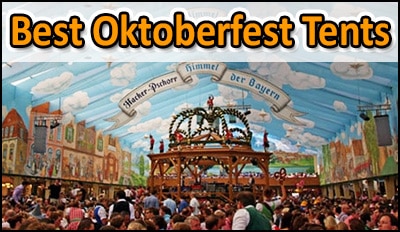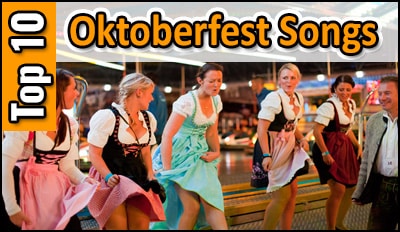Oktoberfest in Munich Germany:
First Oktoberfest: 1810.
Average Attendance: Over 6 million people a year
Who Goes: 70% Bavaria; 15% rest of Germany; and 15% other countries.
Springing out of the celebration from a royal wedding in 1810, Oktoberfest has grown to become the World’s largest festival. Every year over 6 million people get together at the “Wiesn” to dress in traditional Bavarian clothing, play state fair type games, ride roller coasters, dance to oompah music, eat great food, sing with the bands, and of course drink tons of booze. It’s an inviting celebration of life that is so much fun we have planned entire vacations around being able to make it here.
Below is our complete Oktoberfest guide including important event dates and parade schedules. If Oktoberfest in Munich isn’t on your bucket list already, add it right now!
Medieval Festivals In Munich:
The Oktober Volksfest in Bavaria goes back to the Middle Ages and was the predecessor to today’s Oktoberfest. This Volksfest (People’s Fair) started because the local beer brewers needed everyone to drink up the remaining beer at the bottom of the barrels in the Fall as the crops were harvested so they could start a new brew season. Because the beer at the barrels sat much longer it was a lot darker, stronger and was referred to as Dunkel. You will also commonly hear it called the last of the Marzen (March) beer which is any of the beer brewed in the Spring traditional first tapped on May Day. As it sits throughout the year it gets darker. With the Dunkel beer drank and the new batches started, the new batches of beer were put underground to ferment until Spring.
1810: The First Oktoberfest:
The fall festivities for the modern Oktoberfest really took off when Bavarian crown prince Ludwig I married Theresa of Saxe-Hildburghausen on Friday, October 12th, 1810. Ludwig had married Theresa right out from underneath Napoleon so they made sure to make it a grand event. The party lasted for 5 days after the wedding, was attended by 40,000 people, and ended with a large horse race. After the party was over locals started calling the field Theresienwiese (Theresa’s Meadow) in the royal bride’s honor, which locals call Wiesn for short by locals.
This wasn’t the first famous wedding celebration in Munich as in 1546 a huge Medieval tournament and jousting competition was held in Marienplatz in for the marriage of Duke Wilhelm the 5th. This celebration has been immortalized in the 2-story, 28-foot-tall Glockenspiel on Munich’s New Town Hall.
The following year 1811 the horse race from the wedding was added to the October Volksfest & Agricultural Show, but the festival remained largely a farmers market event. Although today there are tons of amusement rides including a roller coaster at Oktoberfest, the 1st ride was a 2 swing carousel added in 1818. All of these early rides were operated by manpower until 1860 when steam power took over before later being replaced by electric motors.
Mid-1800s: Old Traditions Become New:
The first Riflemen and Costume (Tracht) Parade happened in 1835 and has grown to include over 8000 people. The 2-hour long parade continues today snaking through Old Town to Oktoberfest and includes musicians, oxen, horses, riflemen, and even goats all dressed up.
Ludwig I’s son Maximilian II became the King of Bavaria in 1848 and with the people clamoring to bring back the party-style festival from days of his dad’s wedding, Oktoberfest became an official annual event in 1850. As part of the first year, a 36 foot statue of Lady Bavaria was built overlooking the festival grounds. 3 years later the open air columned Hall of Fame (Ruhmeshalle) building opened honoring important people in Bavaria with busts.
They quickly extended Oktoberfest and wanted start a couple weeks earlier for weather, but the farmers also needed the field to grow crops so it took decades before the start was moved. Finally, in 1872 the current dates were set with a 2 week long Oktoberfest ending on the 1st Sunday of October. The only exception to this end date is when the 3rd of October lands after the 1st Sunday of October then the normally 16-day festival will be extended until the 3rd. The 3rd is significant as it was declared the German Day of Unity to commemorates the anniversary of German reunification in 1990.
Late-1800s: Beer Becomes King:
As Oktoberfest transformed more into a party it started out with just some booths, small tents, and a market but grew a lot quicker once electric lights were added in 1880. This growth included the first booths selling bratwurst in 1881 and the addition of the opening day Landlords & Breweries Parade in 1887. The parade was the beginning of Munich’s beer being the focus of Oktoberfest and the farmer’s market element began to take a back seat. Today this parade still happens on the 1st Saturday of Oktoberfest, but is now followed by the much larger Tracht (Marksmen) and Costume Parade the 1st Sunday of Oktoberfest.
Beer started to get upgraded as well as the first beers served in glass mugs began in 1892. These mugs called Maß (mass) replaced beer steins which were at first made out of stoneware. In 1896 the large tents started to replace the smaller beer stalls, just one year after the Armbrustschützen (Crossbowman) began on the grounds. The tents got huge quick and in 1913 the Bräurosl tent already had seats for 12,000 which is still the most ever at Oktoberfest. The big draws were the oompah band music, the food, and of course the Bavarian beer. 1913 was also the last year of horse racing at Oktoberfest.
1950: Opening Keg Tapping Starts:
In 1950 a new tradition was added as the Mayor of Munich now taps the first keg in the Schottenhamel Tent and shouts “O’zapft is!” (It’s tapped!) officially opening Oktoberfest. Since the modern Oktoberfest started in the 1800s it has been canceled a total of 24 times for War and Cholera outbreaks, but has still grown to become the World’s biggest festival with over 6 million visitors a year.


